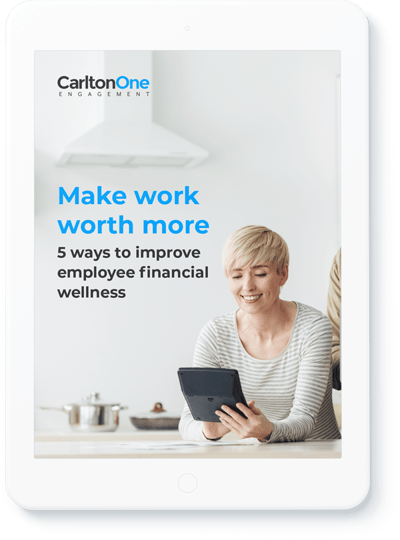Make Work Worth More
Business owners pay their employees, offer them benefits, and if the employees work long enough, they become eligible to contribute to a retirement program—like a 401(k) or RRSP — often with some employer matching.
That’s about the extent of involvement employers have in the financial well-being of their employees. But why isn’t it more?
According to a recent survey by e-commerce platform Jungle Scout, more than half of American consumers are living paycheck to paycheck. People who struggle with their finances have more on their mind than the job they’re supposed to do each day. This reality was confirmed by a another Canadian study that reported lack of financial confidence can generate workplace stress. This can have cascading consequences for the employer, including “lack of engagement, distraction and, ultimately, impaired productivity and higher absenteeism”.
Another financial confidence study in Australia reported that, regardless of job role, income or generation, many employees are uneasy about their current or future financial wellbeing.
Reducing financial stress is good for the business because this pressure can distract employees — negatively affecting their wellbeing, decreasing productivity and impacting organisational wellbeing. Findings show how past and present financial stress affects employees in different areas of their lives:
- 63% experience a negative influence on mood and demeanour
- 44% experience an inability to meet home or family commitments
- 37% report that monetary stressors create health difficulties
- 36% report that monetary stressors create relationship challenges
Internal strife caused by compounded financial woes often accompanies employees to their worksite, where it can lead to increased absenteeism as well as reduced productivity. It’s time companies took a more active role in providing resources to their employees to help them become financially secure so they can become more focused on their work. They will perform better and work harder for an employer that demonstrates concern for their fiscal well-being.
Financial readiness is mission readiness
One of the largest employers in the world — the United States Defense Department — teaches financial readiness to all the women and men in its service. It has an Office of Financial Readiness that offers tools, courses and resources to military members from the moment they start basic training to the time they transition into civilian life.
Soldiers, sailors and Marines who are financially secure can focus on their jobs when they’re deployed, facing fire, or performing mission-critical tasks. Military personnel with high debts also pose a security risk.
So, anytime someone in the military gets married, deploys, returns from deployment, has a child, moves to a new duty station, gets a promotion, etc. they are offered a course that teaches them how their new situation impacts their finances. They learn how to plan for those changes, adjust their budget, review their insurance, tweak their retirement plans, and more.
There are good lessons here for the private sector. Building financial confidence and security removes the distraction of instability, and helps boost focus.
Tip #1: Teach the basics
If you have built a business, you understand the importance of being financially fit. You can’t get lines of credit or loans if you don’t demonstrate a good business model or healthy business performance. Any sized company can host a series of short (in person or virtual) Lunch & Learn financial literacy courses on:
- Budgeting — It’s one of the easiest things to do but not a step enough people take. Sometimes it’s because they’re afraid to see their money situation but taking a frank look at finances is the only way for anyone to improve their financial situation.
- Emergency savings — One of the reasons people live paycheck to paycheck is from amassing high-interest debt to cover unforeseen expenses. It may seem impossible to build an emergency fund but we can show it’s possible.
- Retirement savings — We know the importance of starting early. It’s important to demonstrate that for our employees and show them what they’re working toward.
- Consumer protections — This is especially important for younger employees who have large digital footprints.
- Credit scores — There are so many services that tout free credit reports and ways to boost your credit score. Having been around the block a few times, you can help your employees separate fact from fiction.
These topics may seem basic, but chasing a paycheck can become an endless treadmill that is difficult to stop. Understanding the basics of financial wellness is an empowering first step for employees to take back control.
Tip #2: Introduce a savings benefit program
Helping your employees save on the everyday products they are likely going to buy anyway make good sense. Our latest product launch at CarltonOne is designed specifically to help companies help their employees save money. It’s called Kart, and is a free benefit program that lets employees shop more than 100,000 daily deals on everyday items from popular brands. Shoppers can find discounts on fashion, appliances, electronics, jewelry, gift cards and travel experiences. Also, with just one $50 purchase, users can unlock a year’s worth of coupons for discounts on local restaurants, events and attractions. This is truly purposeful purchasing — giving new meaning to shopping for everyday items, spending less than you would online or at the mall, and automatically funding the planting of trees to fight climate change. In addition to offering deep discounts, shoppers have access to free financing on thousands of items from global financial partnerships that include Affirm. Research has shown tech-savvy shoppers prefer the buy-now-pay-later access provided by microloans like those from Affirm. The convenience of payroll deductions will also be added through CarltonOne’s payroll partnerships.
Tip #3: Make money about more than money
Reframing the conversation and mindset about money is a great way to turn what can be a source of uncertainty into a positive. Creating additional value (beyond monetary) for every employee action is a great start. For example, transactions on every CarltonOne platform will fund climate-change driven eco-action, including the global planting of native trees. Recognizing colleagues with an award, redeeming for a reward, achieving a wellness goal, completing a survey or giving feedback — every action funds the planting of new trees. Nearly 7 million trees have already been planted by our tree partner Eden Reforestation Projects, funded by the daily member activity in our employee engagement tools.
Tip#4: Offer an automated savings plan
One of the most common obstacles to financial wellness (and the confidence of feeling able to weather a financial crisis) is the lack of a formal savings plan. A simple way to help your employees save more money is to enable (or work with a financial institution to offer) an automatic savings program. These programs redirect funds from an employee’s paycheck into an interest-bearing savings or investment account. Employees can choose how much to redirect, and have full access to the funds should they need it. Many companies encourage this type of basic savings plan by offering to match or top-up employee contributions, or waive any bank fees. There’s a dual benefit to these plans — employees can quickly see their savings accumulate, while building more confidence in their ability to be more financially prepared.
Tip#5: Add more flexibility to your benefits
Unexpected health emergencies can also be financially debilitating. In addition to the cost of healthcare, medication and rehabilitation, unpaid leave can significantly damage a family’s wellbeing. Consider offering more flexible health programs that include paid leave, extended job security, health expense reimbursement, or childcare benefits. Companies that can help their employees and families when they need it most, are often repaid with higher retention rates and employee engagement. These unorthodox benefits can also help you attract new candidates.
The business benefits
When someone is ONLY working for their next paycheck, they fall into the category of being disengaged in their work. They’re going through the motions, not innovating or learning. If you can create a the opportunity for more financial wellness and confidence, you give them more meaning in their work. And when you can make work mean more, you unlock extraordinary levels of loyalty, performance and ingenuity.
Make Work Worth More
Business owners pay their employees, offer them benefits, and if the employees work long enough, they become eligible to contribute to a retirement program—like a 401(k) or RRSP — often with some employer matching.



